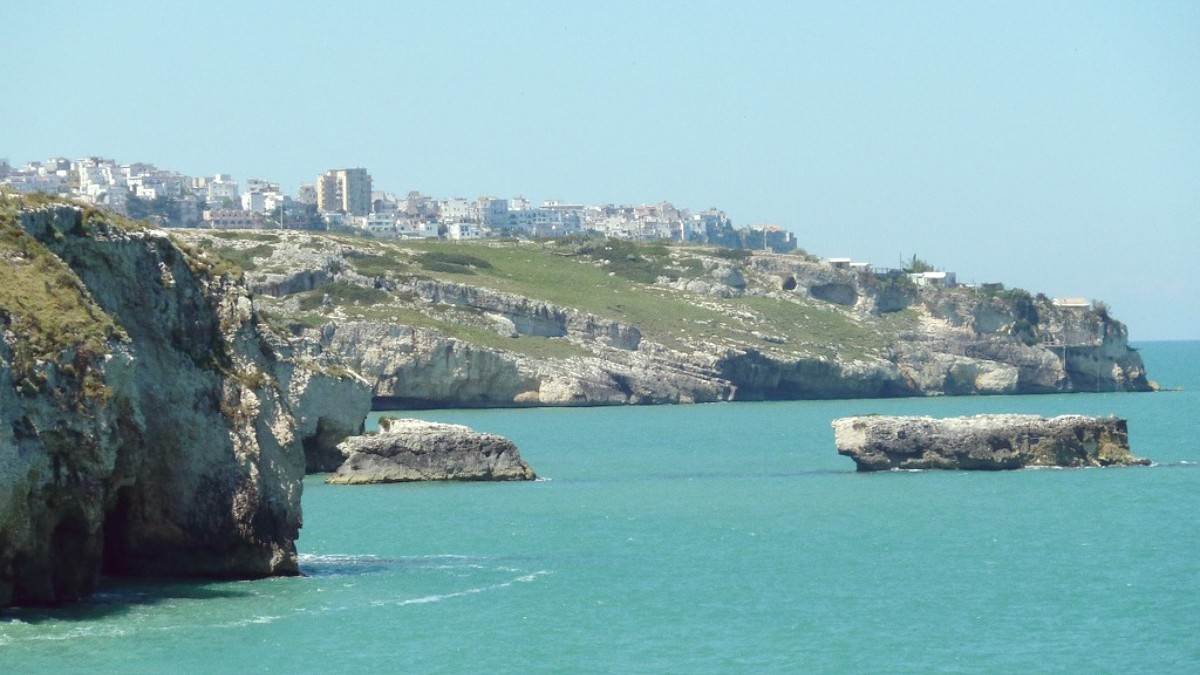
Puglia, Italy
Summer (June-August): These months bring hot, dry weather. Average temperatures range from 25°C to 30°C (77°F to 86°F). July and August often see temperatures climb above 35°C (95°F). Humidity remains moderate. Precipitation is very low, establishing these months for beach activities. The sun shines brightly for long hours each day.
Autumn (September-November): The weather becomes progressively milder and wetter. September remains warm with average temperatures between 20°C and 25°C (68°F and 77°F). October sees averages from 15°C to 20°C (59°F to 68°F). Rainfall increases significantly, specifically in October and November. Days feel pleasant for walking, though evenings become cooler.
Beach and Swimming: June, July, August, and September present optimal conditions for enjoying Vieste's beaches and sea.
Hiking and Outdoor Exploration (Gargano National Park, Umbra Forest): April, May, late September, and October present pleasant temperatures, avoiding summer heat and making comfortable walks possible. Cultural Sightseeing and Town Exploration: May, June, September, and October present pleasant temperatures and fewer crowds, making exploration of Vieste Vecchia and other historical sites more enjoyable. Boat Tours to Sea Caves/Tremiti Islands: These tours operate mainly from May to September. Always verify ferry and tour schedules; they are seasonal and weather-dependent. Early morning tours can feature calmer seas and better light for photography.
Crowds & High Prices
Hottest weather, warmest sea, all tourist facilities open.
Largest crowds, highest prices, intense heat, parking difficulty.
Balance & Value
Pleasant temperatures, fewer crowds, lower prices, ideal for hiking.
Fewer establishments open early/late season, cooler sea, less frequent ferries.
Authentic & Affordable
Very few tourists, authentic local experience, lowest prices.
Cooler weather (no swimming), many tourist businesses closed, reduced services.
Italy is a member of the Schengen Area, a group of 27 European countries that operate as a single jurisdiction for international travel. Non-EU citizens typically do not need a visa for short tourist stays, specifically up to 90 days within any 180-day period. This travel freedom extends between Schengen countries upon entry to the area. US Citizens: Citizens of the United States do not require a visa for tourist or business stays of up to 90 days within a 180-day period in the Schengen Area. This applies to most other non-EU countries like Canada, Australia, and New Zealand.
Travelers from countries not covered by the visa-waiver agreement must apply for a Schengen visa before their trip. The application process usually calls for submitting forms, documents, and biometric data to the Italian embassy or consulate in your home country. This process can take several weeks or months, so plan well in advance. ETIAS (European Travel Information and Authorisation System): Starting mid-2025 (date subject to change), visa-exempt non-EU nationals, including US citizens, will need to apply for an ETIAS travel authorization online before their trip. This is not a visa but a pre-travel authorization. Application is straightforward and typically involves a small fee. Once approved, it will be valid for three years or until your passport expires.
Valid for 3 months beyond departure, issued within 10 years, 2 blank pages.
Proof of return ticket or onward travel.
Proof of funds for your stay (bank statements, credit cards).
Confirmation of bookings or invitation letter.
Recommended for all; €30,000 medical coverage needed for Schengen visa.
Italy uses the Euro (€), the standard currency across the Eurozone.
The official currency is the Euro (€). ATMs, known as "Bancomat," are widely available. Credit and debit cards (Visa, Mastercard) enjoy broad acceptance. Carrying some cash advisable for smaller purchases, local markets, and some family-run establishments. Inform your bank of travel plans to avoid card suspension.
Tipping is not mandatory in Italy; it is less common than in the United States. It views itself as a bonus for good service rather than an expectation.
Hostel bed: €25-€45. 3-star Hotel room: €80-€160 (peak summer prices higher). Personal size pizza: €7-€15. Mid-range restaurant meal: €25-€50. Local urban bus ticket: €1.50-€2.50. Boat tour of sea caves: €20-€30.
Italy is a safe country for tourists. Awareness of common concerns allows for preparedness.
Present in coastal areas. Use Insect repellent, especially at dusk.
Practice good food hygiene, wash hands frequently, eat at busy places.
Emergency Number: 112 (General European Emergency Number)
Italy has a public healthcare system. Non-EU citizens typically need travel insurance for private medical care. Pharmacies ("farmacia," green cross) are widely available for minor ailments and over-the-counter medications. Vieste has a small local hospital.
Other emergency numbers: 118 (Medical Emergency), 113 (Police), 115 (Fire Brigade).
Always consult your healthcare provider 4-6 weeks before travel for vaccination advice.
Travel insurance storefront for adventurous travelers.
Insurance crafted for digital nomads and remote teams.
Provides medical and travel-related coverage for foreigners visiting the United States.
Vieste is generally a safe destination with low crime rates. Petty crime, like pickpocketing, is rare but possible in crowded areas. No specific neighborhoods are known for high crime.
Resources for a safer journey.
LifeStraw: Consumer site for water filtration products.
Adventure Medical Kits: First aid supplies for travelers.
Pacsafe: Anti-theft bags and travel security products.